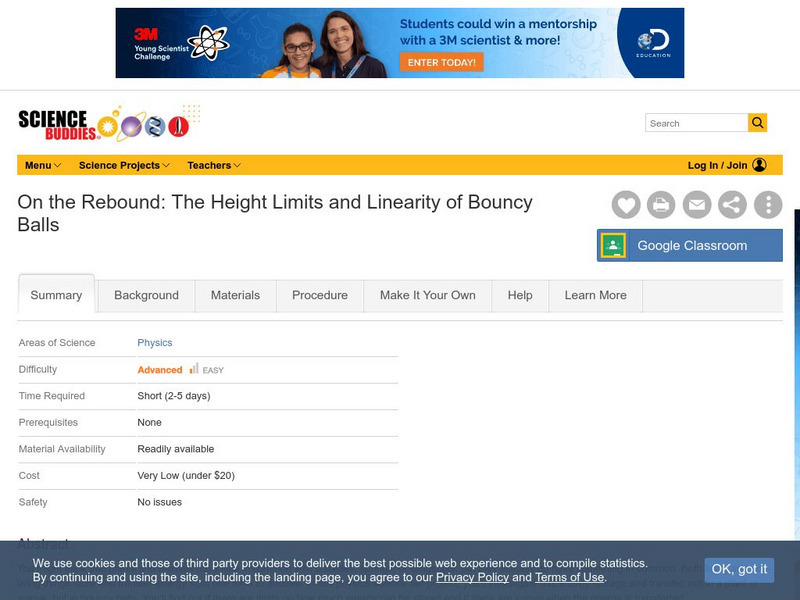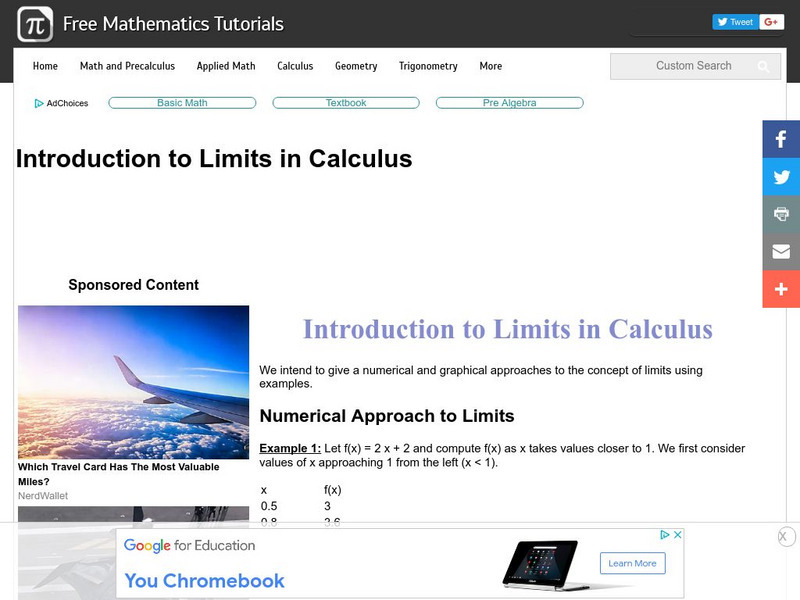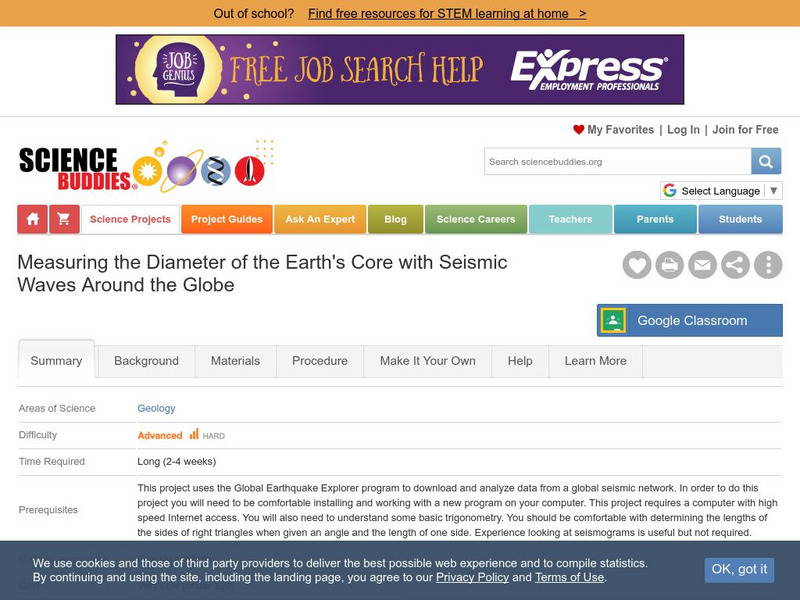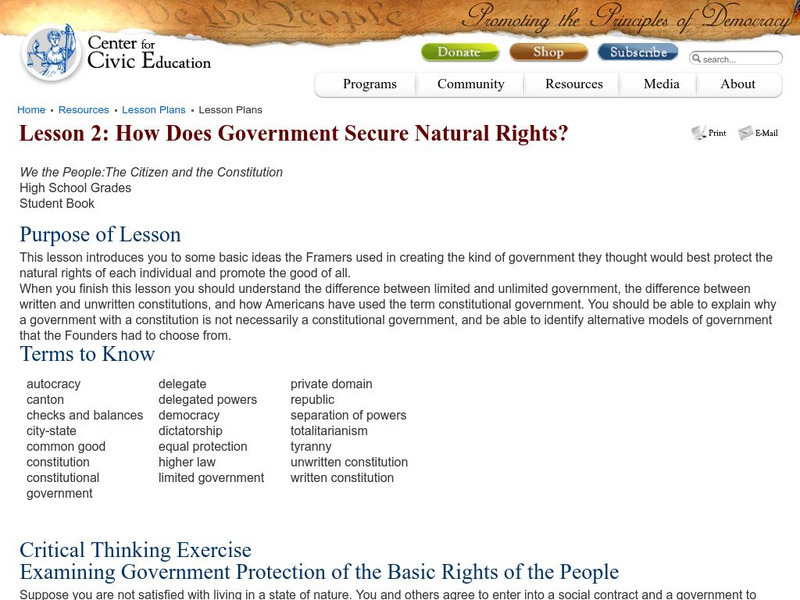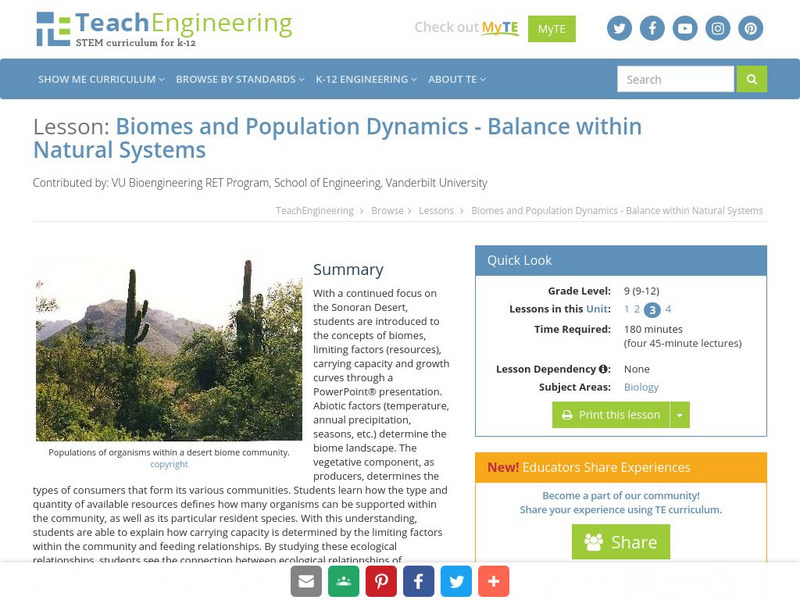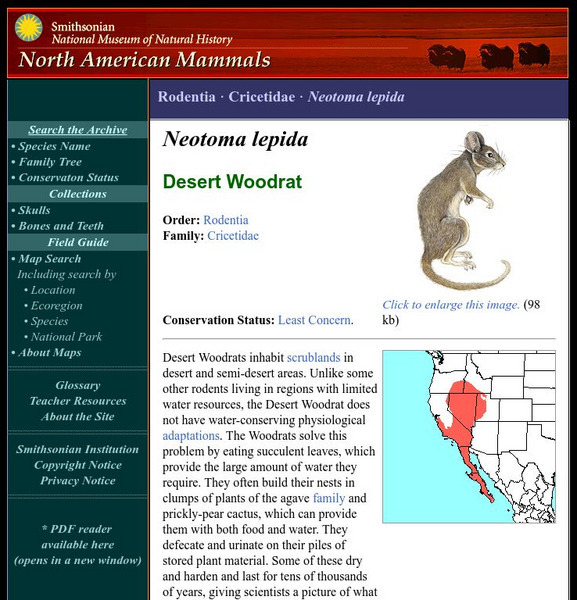Hi, what do you want to do?
Shmoop University
Shmoop: Multiplying and Dividing Limits Examples
Examples of multiplication and division of limits with the solutions.
Science Buddies
Science Buddies: The Height Limits and Linearity of Bouncy Balls
You might think that plants and animals have little in common with batteries, springs, or slingshots, but they actually do have something in common. Both living and non-living things store and transfer energy from one form to another. In...
Analyze Math
Analyze Math: Introduction to Limits in Calculus
The tutorial investigates numerical and graphical approaches to calculating the limit of a function. Examples with detailed solutions are included.
Other
Raising Children Network Limited: Changing Routines: Autism
This resource provides strategies to use with students who struggle with changes in transitions and daily routines. Examples of changes in routines are provided, along with visual strategies and social stories. These tools may be used...
Other
Brefi Group Limited: Self Directed Learning
Learn about self-directed learning and the 3 models provided: facilitated learning groups, community learning, and self-directed development programs. Each model is discussed in detail with links to a plethora of related resources.
Alabama Learning Exchange
Alex: S'mores Limiting & Excess Reactants
Students will use manipulatives that represent the ingredients for S'mores (graham crackers, marshmallows, chocolate bar) to determine the limiting and excess reactants (reagents) for making S'mores. The students will extend this to...
Science Buddies
Science Buddies: Measuring the Earth's Core With Seismic Waves
When an earthquake occurs, seismic shock waves travel out through the earth from the source of the event. The shock waves travel through the earth (body waves), or along the Earth's surface (surface waves), and can be recorded at remote...
Math Open Reference
Math Open Reference: Limits: An Informal Overview
Gain an understanding of limits with this helpful reference tool. Provides a detailed definition and examples that enhance further explanation. Includes links to related topics.
California State University
Cal State San Bernardino: Central Limit Theorem Applet
In this applet, rolling of dice is studied. The number that lands face "up" on the die is graphed as the die is rolled repeatedly. The user begins to see, with increased accuracy, the standard normal curve appearing as the graph.
CNN
Cnn: Supreme Court Upholds and Limits Affirmative Action
Great article that discusses the recent Supreme Court case dealing with affirmative action and college admission (University of Michigan Cases). Includes links to other resources as well as discussion and activities for parents and...
Other
Infinitec: Work and Assistive Technology
Work is about finding a way to effectively complete a task. Many new Assistive Technology (AT) devices are available to help people get work done by new means, such as by dictating text to a voice recognition program, or by having...
Center For Civic Education
Center for Civic Education: How Does Government Secure Natural Rights?
This lesson introduces students to some basic ideas the Framers used in creating the kind of government they thought would best protect the natural rights of each individual and promote the good of all. At the end of the lesson, students...
PBS
Pbs: American Experience: Richard M. Nixon: Foreign Affairs
Overview of the foreign policy of the Nixon administration with a focus on China, the Strategic Arms Limitation Treaty with the U.S.S.R., and Vietnam.
Other
Marketography: Conflict Perspective: A Mediated Culture
Examines mass media and its relationship with society. In the past, it was a one-way relationship and mass media influenced society. Now it works in both directions, with society providing feedback to and influencing mass media. The...
TeachEngineering
Teach Engineering: Biomes and Population Dynamics
This instructional activity begins with a PowerPoint slideshow that covers important ecological concepts about biomes, limiting factors, carrying capacity, and population growth. Learners will look at the population dynamics involved...
US National Archives
National Archives: Teaching Six Big Ideas in the Constitution
The Constitution can be broken down into 6 main themes: Limited Government, Federalism, Republicanism, Separation of Powers, Checks and Balances, and Popular Sovereignty. Students will study background on the Founding Fathers and use...
Geographypods
Geographypods: Introducing Global Development
This exercise has five objectives: to find out how big the gap between rich and poor is, to learn a little more about the issues facing people with limited access to food around the world and the features and extent of malnutrition, to...
Council for Economic Education
Econ Ed Link: Don't Fence Me Out! (Barriers to Trade)
We tend to see the United States as a country with free trade. Although we do have a great deal of freedom to enter new markets, there are barriers to trade that limit consumer choice. This lesson explores these barriers and how they work.
TED Talks
Ted: Ted Ed: The Infinite Hotel Paradox
The Infinite Hotel, a thought experiment created by German mathematician David Hilbert, is a hotel with an infinite number of rooms. Easy to comprehend, right? Wrong. What if it's completely booked but one person wants to check in? What...
Other
Fairchild Tropical Botanic Garden: What Are Adaptations [Pdf]
This pdf presents a thorough examination of plant adaptations with emphasis on different types of functional and reproductive adaptations.
Other
Clayton State: Organizing & Presenting a Frequency Dist.
The easiest method of organizing data is a frequency distribution, which converts raw data into a meaningful pattern for statistical analysis. Learn how in this tutorial with examples.
Other
University of Wisconsin Green Bay: Faults and Earthquakes
This site is primarily set up as an outline and is loaded with graphs, maps, and images. It covers a variety of earthquake-related topics, such as what causes earthquakes, fault lines and structures, seismology, a historical look at...
Smithsonian Institution
National Museum of Natural History: American Mammals: Desert Woodrat
Desert Woodrats inhabit scrublands in desert and semi-desert areas. Unlike some other rodents living in regions with limited water resources, the Desert Woodrat does not have water-conserving physiological adaptations. Learn more about...
Other
Fayetteville State University: Standard Error
Standard error is discussed in terms of the Central Limit Theorem. The site mentions "Rule 3 of the CLT" as a means to eliminate the error. Here that process is validated in reason and supported with an example.






